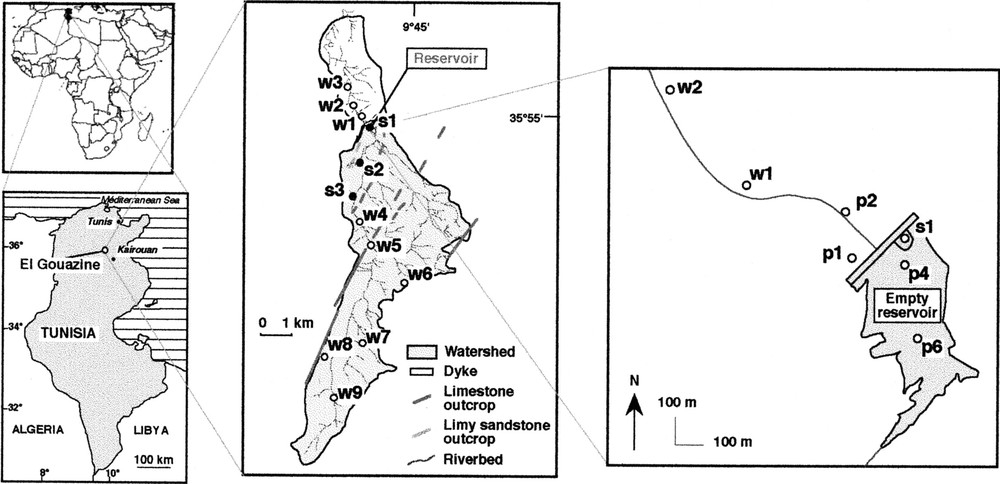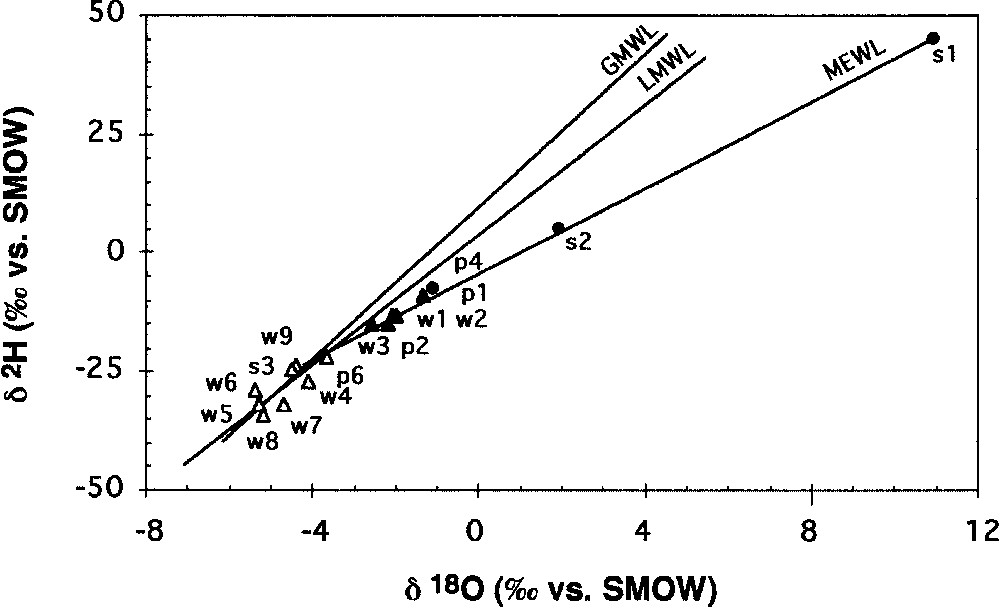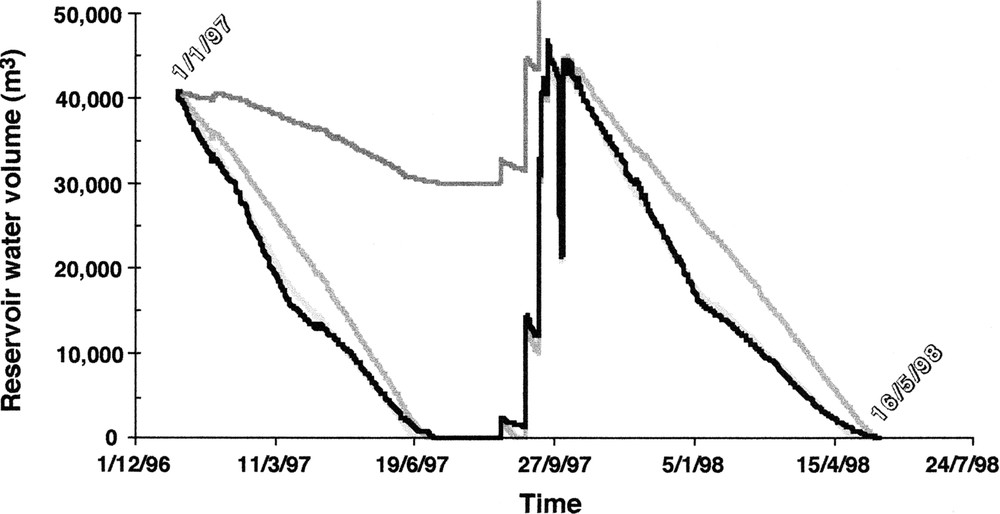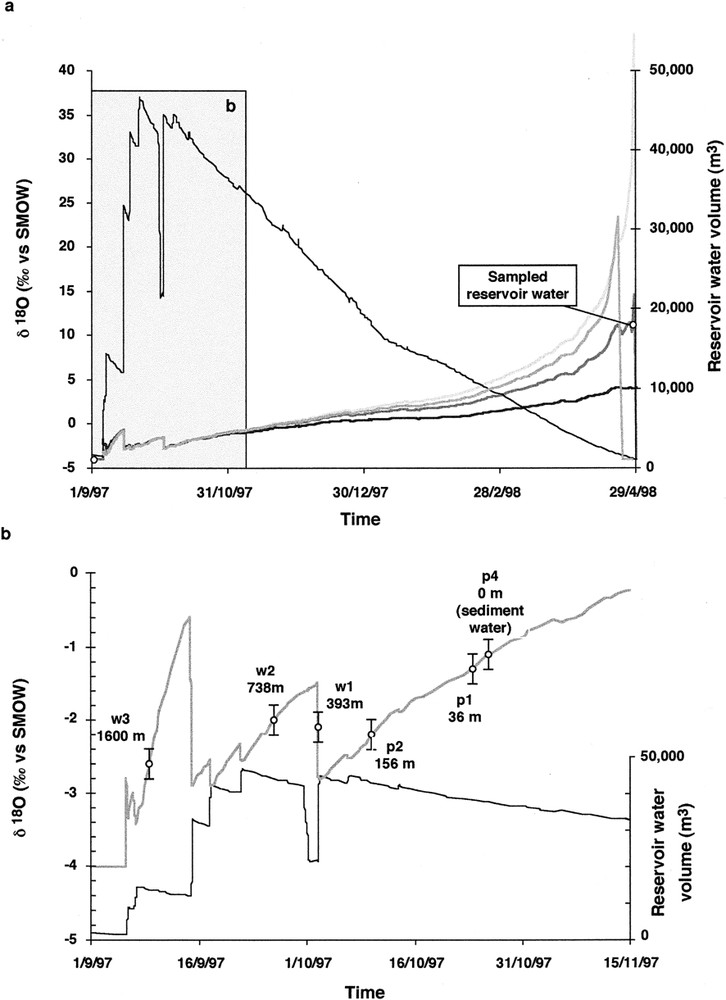Version française abrégée
1 Introduction
Plusieurs centaines de retenues collinaires construites en Tunisie centrale [1,26] permettent la recharge de la nappe alluviale. Une importante infiltration souterraine est manifeste lorsque le bilan hydrologique annuel est fortement négatif. Les isotopes stables 18O et 2H peuvent être utilisés pour améliorer la connaissance du bilan hydrologique souterrain entre lac et aquifère [2,15]. L'objectif de l'étude est d'évaluer le bilan hydrologique souterrain d'une retenue collinaire infiltrante et de déterminer les conséquences de ce bilan sur l'aquifère alluvial aval.
2 Matériels et méthodes
La retenue d'El Gouazine est située en Tunisie centrale, à environ 50 km au nord-ouest de Kairouan (35°55′N–9°45′E ; altitude 375 m) et forme un bassin versant de 18,1 km2 (Fig. 1). Le remplissage de la retenue, construite en 1990, est très variable sous climat méditerranéen. La pluviométrie moyenne annuelle est de 344,2 mm pour la période 1994–2000 et la moyenne annuelle de l'évaporation en bac classe A est 1745,4 mm pour la période 1996–2000. Le bilan hydrologique annuel de la retenue est compris entre

Location of the El Gouazine watershed in Tunisia (North Africa) with water sampling sites highlighted (● surface waters, ○ ground waters).
Localisation du bassin versant d'El Gouazine en Tunisie (Afrique du Nord) et indication des sites d'échantillonnage d'eau (● eaux de surface, ○ eaux de nappe).
Du 14 au 23 mai 1998, 13 échantillons d'eau de nappe ont été prélevés dans des puits (9) et des fosses (4), répartis dans le bassin versant et en aval de la retenue presque vide. Trois échantillons d'eau de surface ont été collectés dans et autour de la retenue (Fig. 1). Les teneurs isotopiques mesurées d'après [13] et [10] sont exprimées en δ‰ vs V-SMOW, avec une précision de
3 Résultats
Les teneurs isotopiques des eaux de nappe du bassin versant (w4 à w9, p6 et s3) sont présentées dans le Tableau 1. Les valeurs appartiennent aux droites des eaux météoriques globale GMWL [11] et locale LMWL [7] et sont en accord avec [18] (Fig. 2). Les eaux de surface (s1 et s2) et de sédiment (p4) sont enrichies en isotopes stables par évaporation, tandis que les teneurs isotopiques des eaux de la nappe aval (w1, w2, w3, p1 et p2) sont intermédiaires entre celles de la retenue et celles de la nappe amont. Les résultats suggèrent que l'eau de la retenue, qui est plus ou moins soumise à l'évaporation, est un mélange entre les eaux de surface (pluie, ruissellement) et la nappe alluviale amont, d'origine météorique. La nappe alluviale aval présente la composition isotopique d'une eau de la retenue anciennement infiltrée.
Stable isotope (18O and 2H) composition of water samples from the El Gouazine site in May 1998
Composition en isotopes stables (18O et 2H) des eaux du site d'El Gouazine en mai 1998
| Sample | Label | Date | 18O (‰) | 2H |
| Evaporated water | ||||
| Reservoir water | s1 | 14/05/98 | 10.9 | 45.4 |
| Surface water | s2 | 14/05/98 | 1.9 | 5.3 |
| Pit | p4 | 23/05/98 | −1.1 | −7.7 |
| Downstream groundwater | ||||
| Well | w1 | 17/05/1998 | −2.1 | −13.2 |
| Well | w2 | 21/05/1998 | −2.0 | −13.0 |
| Well | w3 | 21/05/1998 | −2.6 | −15.1 |
| Pit | p1 | 21/05/1998 | −1.3 | −9.1 |
| Pit | p2 | 21/05/1998 | −2.2 | −15.5 |
| Upstream groundwater | ||||
| Well | w4 | 16/05/1998 | −4.1 | −25.5 |
| Well | w5 | 16/05/1998 | −5.3 | −31.1 |
| Well | w6 | 16/05/1998 | −5.4 | −28.9 |
| Well | w7 | 23/05/1998 | −4.7 | −32.0 |
| Well | w8 | 16/05/1998 | −5.2 | −33.9 |
| Well | w9 | 21/05/1998 | −4.4 | −23.5 |
| Pit | p6 | 22/05/1998 | −3.6 | −22.1 |
| Seepage | s3 | 14/05/1998 | −4.5 | −24.3 |

Relationship between 2H and 18O for samples of surface and ground water from the El Gouazine site. GMWL, global meteoric water line (
Relationship between 2H and 18O for samples of surface and ground water from the El Gouazine site. GMWL, global meteoric water line (
Relation entre 2H et 18O pour les eaux de surface et de nappe du site d'El Gouazine. GMWL, droite globale de l'eau météorique (
Relation entre 2H et 18O pour les eaux de surface et de nappe du site d'El Gouazine. GMWL, droite globale de l'eau météorique (
Le meilleur ajustement du modèle hydrologique est obtenu pour des valeurs de

Simulation of water volume change over time in the El Gouazine reservoir. Bold-black line, measured water volume; dark-grey line,
Simulation de l'évolution temporelle du volume d'eau dans la retenue d'El Gouazine. Trait en noir foncé, volume d'eau mesuré ; trait en gris foncé,
Simulation de l'évolution temporelle du volume d'eau dans la retenue d'El Gouazine. Trait en noir foncé, volume d'eau mesuré ; trait en gris foncé,

(a) Simulation of the 18O content over time for water from the El Gouazine reservoir during the period 1997–1998. Bold-black line,
(a) Simulation of the 18O content over time for water from the El Gouazine reservoir during the period 1997–1998. Bold-black line,
(a) Simulation de l'évolution temporelle de la teneur en 18O pour l'eau de la retenue d'El Gouazine durant la période 1997–1998. Trait noir foncé,
(a) Simulation de l'évolution temporelle de la teneur en 18O pour l'eau de la retenue d'El Gouazine durant la période 1997–1998. Trait noir foncé,
Comme les valeurs isotopiques mesurées dans la nappe alluviale aval correspondent à des valeurs isotopiques d'une eau de la retenue anciennement infiltrée, on dispose sur la Fig. 4b, qui constitue un agrandissement de la Fig. 4a, les points de mesure suivant un ordre logique et on en déduit les dates relatives à l'acquisition du signal isotopique. Connaissant la distance
Estimate of leakage from the El Gouazine reservoir in May 1998.
Estimation des pertes par infiltration de la retenue d'El Gouazine en mai 1998.
| Label | 18Oa |
Date | ||||||||
| p4 | −1.1 | 30/10/1997 | – | – | – | – | 0 | 0 | – | 0 |
| 36 | 5 | 7.2 | 1500 | |||||||
| p1 | −1.3 | 25/10/1997 | – | – | – | – | 36 | 5 | 7.2 | 1500 |
| 120 | 14 | 8.6 | 4200 | |||||||
| p2 | −2.2 | 11/10/1997 | – | – | – | – | 156 | 19 | 8.2 | 5700 |
| 237 | 8 | 29.6 | 2400 | |||||||
| w1 | −2.1 | 03/10/1997 | – | – | – | – | 393 | 27 | 14.6 | 8100 |
| 345 | 6 | 57.5 | 1800 | |||||||
| w2 | −2.0 | 27/09/1997 | – | – | – | – | 738 | 33 | 22.4 | 9900 |
| 862 | 18 | 47.9 | 4750 | |||||||
| w3 | −2.6 | 09/09/1997 | – | – | – | – | 1600 | 51 | 31.4 | 14 650 |
a Measured data;
b estimated data from Fig. 4b;
c calculated data from water isotope budget modelling.
4 Conclusion
La modélisation hydrologique des variations quotidiennes du volume de la retenue montre que l'on peut estimer le bilan hydrologique souterrain d'un lac collinaire. Pour le lac collinaire d'El Gouazine, le bilan est négatif et est de
1 Introduction
Numerous water and soil conservation projects are planned for Mediterranean countries such as Central Tunisia, where several hundreds hill reservoirs have been constructed in a range of environments [1,26]. Among the benefits of using rain-harvesting constructions such as hill reservoirs is the recharge of adjacent groundwater supplies, which acts as an efficient mechanism for preserving water resources compared with separate water storage facilities that allow evaporation but no groundwater recharge. Current methods of determining the surface hydrological budget of hill reservoirs by monitoring water level, rainfall and evaporation neglect the important influence of groundwater infiltration. The importance of infiltration is evident when annual surface water budgets are highly negative. Unfortunately, understanding this process is hampered by the lack of knowledge about the hydrological budget of infiltrated groundwater. As intrinsic components of the H2O molecule, the stable isotopes 18O and 2H can be measured and used to distinguish between waters from different sources, hence they can improve the knowledge of groundwater balance between lake or reservoir and aquifer [2,15].
The objective of our research has been to assess the groundwater balance for an infiltrated hill reservoir and determine the consequences of this balance for the adjacent alluvial aquifer.
2 Materials and methods
2.1 Study site
The El Gouazine hill reservoir is located approximately 50 km northwest of the city of Kairouan (35°55′N–9°45′E ; 375 m elevation) in Central Tunisia. The reservoir is situated at the outlet of an 18.1 km2 watershed (Fig. 1). Constructed in 1990, the reservoir consists of a 232-m-long dyke constructed of earth materials and has a maximum capacity of 233 370 m3. Replenishment of the reservoir is highly variable owing to the complexities of the Mediterranean climate. The mean annual rainfall in the watershed was 344.2 mm during the period from 1994 to 2000. Class-A pan evaporation in the watershed far exceeds rainfall each year with a mean annual evaporation amount of approximately 1745.4 mm estimated for the period from 1996 to 2000 [8]. The surface hydrological budget has been monitored since 1994 and the annual value is ranging from
The El Gouazine watershed is located at the east boundary of the SW–NE-oriented Ousseltia syncline [6,17]. The elevation of the watershed regularly decreases from 575 to 375 m in the vicinity of the reservoir. Soil formations (mainly calcrete calcisols and calcaric cambisols) have developed on underlying Tertiary sedimentary units [14], which were intensely folded during the formation of the Atlas Mountains, approximately 40 million years ago with these tectonic movements producing nearly vertical rock layers that dip steeply to the southeast in the eastern part of the watershed.
The reservoir is affected by only small amounts of siltation each year and, since the reservoir construction in 1990, the volume of accumulated clayey and coarse sediments has been 16,030 m3. This accumulation has led to sediment deposits of nearly 3 m thickness that effectively make the reservoir impermeable. However, a sandy layer, formed by weathering of a calcareous sandstone, is present on the western embankment of the reservoir and is thought to promote leakage when the reservoir is replenished [20,21]. When the reservoir is full, the maximum water depth is less than 5 m and no water stratification is recorded [25]. Detrital materials are deposited in the riverbed, leading to the formation of a temporary alluvial aquifer that has been exploited by the construction of wells to meet agricultural and domestic water needs. The alluvial aquifer downstream of the reservoir, laterally delimited by the mean water channel width, is characterized by a 0.01-m m−1 hydraulic gradient, a transmissivity ranging from 0.2 to
2.2 Water sampling and analytical methods
From 14 to 23 May 1998, water samples were taken from six wells in the reservoir watershed, three wells in the alluvial aquifer downstream of the reservoir and four pits both from downstream and within the almost empty reservoir. Three water surface samples were also collected within and around the reservoir (Fig. 1). The analysis of stable isotopes in the water samples was conducted at the Paris-11–Orsay University using the Epstein–Mayeda [13] and Coleman et al. [10] techniques. Isotope ratios were measured using a mass spectrometer and are expressed as δ‰ vs V-SMOW values with an analytical precision of
| (1) |
2.3 Water budget modelling
The reservoir water budget is calculated using a recursive model linking the stored water volumes
| (2) |
2.4 Water isotope budget modelling
The reservoir water isotope budget for each day is calculated using the following recursive model:
| (3) |
Several assumptions are required: (i) as, after [4], the isotope ratio
3 Results
3.1 Isotope water content
The isotope contents of the watershed groundwater (w4 to w9, p6 and s3) range from −5.4 to −3.6
Reservoir water (s1), surface water (s2) and sediment water (p4) are enriched with stable isotopes during the evaporation process. Waters downstream of the reservoir (w1, w2, w3, p1 and p2) are weakly enriched with both
3.2 Input and output groundwater fluxes
The best fit for the water budget model is given by
We assume that the measured 18O contents of downstream groundwater are the 18O contents of a previously infiltrated reservoir water. Hence, in Fig. 4b, which is a detailed part of Fig. 4a, the isotope contents in groundwater samples are plotted following a logical order and we infer the time corresponding to the acquisition of the isotope signal by the water sample based on the distance of the sampling point to the reservoir, assuming a known velocity of groundwater. Knowing the downstream distance
4 Conclusion
Quantification of the groundwater balance surrounding a hill reservoir has been possible using water budget modelling. For the El Gouazine reservoir, the groundwater balance is negative and ranging from
Moreover, as the stable isotope composition of the waters in an alluvial aquifer drastically changes with the construction of a hill reservoir, the presence of such reservoirs in the landscape must be taken into account when planning strategies for sampling water for stable isotope analysis during regional surveys.
Acknowledgments
This study was sponsored from 1998 to 2001 by the European Union project Hydromed (ERBIC 18 CT 960091), managed by J. Albergel from IRD.


